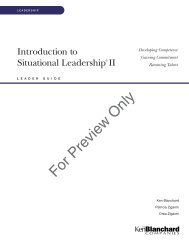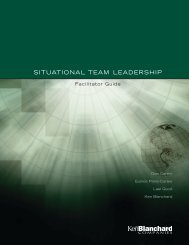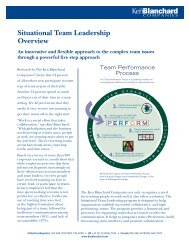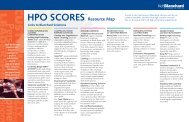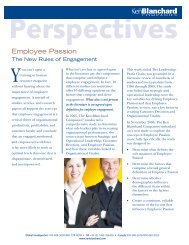Critical Leadership Skills - Ken Blanchard
Critical Leadership Skills - Ken Blanchard
Critical Leadership Skills - Ken Blanchard
- No tags were found...
Create successful ePaper yourself
Turn your PDF publications into a flip-book with our unique Google optimized e-Paper software.
<strong>Critical</strong> <strong>Leadership</strong> <strong>Skills</strong>Key Traits That Can Make or BreakToday’s LeadersResearchFindingsStrong leadership is the backbone of an organization. Leaders createthe vision, support the strategies, and are the catalyst for developing theindividual bench strength to move the organization forward.Yet leadership can be an elusive characteristic, and developing leaders totheir full potential remains one of the great challenges for organizationstoday. Upcoming demographic changes threaten to send numerous babyboomers that are currently in leadership positions into retirement. This willmake developing leadership bench strength an even greater challenge fororganizations to resolve in order to remain competitive in the future.In four separate studies, conducted in 2003 through 2006 by The <strong>Ken</strong><strong>Blanchard</strong> Companies ® , 2,004 respondents cited developing leadershipbench strength as their number one issue. In order to understand anddefine the most critical components of effective leadership, The <strong>Ken</strong><strong>Blanchard</strong> Companies launched a follow-up study in which more than 1,400leaders, managers, and executives shared their views on the critical skillsand common mistakes connected to leadership.Summary• The ability to communicate appropriately is an essential componentfor effective leadership. In the follow-up study, 43% of respondentsidentified communication skills as the most critical skill set, while 41%identified the inappropriate use of communication as the number onemistake leaders make.• Effective people management was the second most important skill setidentified. The application of appropriate direction and support, andthe involvement and valuing of employee input were seen as critical tosuccess—and a critical mistake if not practiced.• Empathy and emotional intelligence are cited as the third most importantskill set leaders can possess. This area was cited by 15% of respondents ascritical for leadership success. The leaders’ ability to put others beforethemselves, to empathize, to seek to understand and build rapport, andto show concern allows them to connect with their direct reports. Thisskill directly impacts the ability to build an environment based on trust,which allows people to flourish and to achieve their full potential.
Survey DetailsQUESTION 1: What is the biggest mistake leaders makewhen working with others? (Open-ended question)Inappropriate use of communication/listeningInappropriate communication was cited as the number onemistake leaders make. Too often leaders either don’t communicate,overcommunicate, communicate inappropriately through outbursts,anger, or blaming, or simply don’t communicate clearly. In addition,leaders may fail to communicate the vision in a way that is meaningful,assuming that direct reports intuitively understand the direction of thecompany and their role in making this happen. Another critical mistakeis lack of clear communication regarding(Biggest mistake leaders make when working with others)roles, goals, expectations, and theimportance of specific behaviors or goal1. Inappropriate use of communication or listening 41% accomplishment, all of which undermine2. Under- or oversupervising, direction, or delegation 27% individual productivity and performance.In addition, failing to listen to feedback,3. Lack of management skills 14%ignoring alternative viewpoints, or failing4.5.Lack of support/inappropriate supportLack of accountability12%5%to seek clarity through active listening canundermine leadership effectivenessand trust.Over- or undersupervising, delegating, or directingProviding inappropriate direction was the second most highly citedleadership mistake. Giving direction without involving others in theprocess, not seeking the feedback of others, and not empowering directreports can cause frustration and lack of focus. In addition, using ageneralized approach to direction rather than considering the person,task, and situation was cited as a key mistake made by leaders. Lastly,using a bureaucratic or controlling delegating style was seen as anineffective way to lead others.Lack of management skillsRespondents cited a lack of generic management skills, such as problemsolving, decision making, and consensus building, as a key problem inineffective leadership.Lack of support or inappropriate supportNot supporting, believing in, or championing direct reports was cited as aproblem area that can undermine leadership effectiveness. Leaders whoignore or overlook the accomplishment of or progress toward goals canfrustrate direct reports. Alternatively, providing too much support in anysituation can also be frustrating and be viewed as micromanaging to adirect report who is a peak performer.Lack of accountabilityNot holding employees accountable for achieving agreed-upon goalsand behavior is another key issue identified as a critical mistake made byleaders. Further, respondents said that leaders who don’t hold themselvesaccountable for agreed-upon goals and behaviors can send mixedmessages to direct reports and foster animosity. Not following through oncommitments undermines trust and respect in all relationships.MK0487 042406 <strong>Critical</strong> <strong>Leadership</strong> <strong>Skills</strong> 2
(Most critical leadership skill)1. Communication/listening 43%2. Effective management skills 17%3. Emotional intelligence and empathy 15%4. Values and integrity 8%5. Vision 6%6. Empowerment 6%QUESTION 2: What is the most critical skill a leader can possesswhen working with others? (Open-ended question)Communication/listeningCommunication is identified as the most critical leadership skill. The abilityto listen, read body language, ask questions, provide feedback, and generateeffective two-way communication builds trust and can prevent performanceproblems down the road. In addition, the ability to comfortably use a variety ofcommunication styles in order to articulate goals and objectives paves the wayfor healthy working relationships at every level within an organization. Providingrelevant information allows employees to participate fully in their work.Effective management skillsMany respondents felt that the second mostcritical skill a leader could possess when workingwith others is to develop others by applyingthe appropriate leadership style based on theindividual’s skills, needs, and performance. Thismeans taking a situational approach to leadership.In addition, respondents stated that the mosteffective leaders acted as a model for the behaviorsthey were seeking and also as a coach for bothindividuals and teams.Emotional Intelligence and empathyAnother significant and critical skill leaders can possess is the ability to putthe needs, issues, and concerns of their people ahead of their own. The abilityto empathize, understand, build rapport, show concern, encourage, engage,and connect with direct reports is key. Valuing others, focusing on individualuniqueness, and preserving an individual’s dignity provides an environment ofempowerment.Values and integrityIn order to inspire and lead others, a leader must possess tremendous honestyand integrity, and be a role model who leads by example. Leaders with a strongsense of character and humility have a sense for doing the right thing because itis the right thing, not because they expect something in return.VisionLeaders must have a sense of the big picture and the ability to communicateand mobilize people around a shared vision. Being able to translate the visionand goals into the language of each person and then cascading that into theireveryday job is seen as a critical skill. Collective movement toward a sharedvision motivates and inspires people to communicate.EmpowermentAs one respondent put it, “The ‘follow-me’ era is passé.” Today’s leaders need toput their people first, translate the vision, and empower their people to achieveit by providing the knowledge, skills, and the opportunity to perform. Involvingothers and encouraging them to take ownership instills a sense of pride that canunleash performance and productivity.MK0487 042406 <strong>Critical</strong> <strong>Leadership</strong> <strong>Skills</strong> 3
(The top five things leaders fail to do)1. Failing to provide appropriate feedback (praise, redirection) 82%2. Failing to listen to or involve others in the process 81%3. Failing to use a leadership style that is appropriate to the person,task, and situation (oversupervising or undersupervising) 76%4. Failing to set clear goals and objectives 76%5. Failing to train and develop their people 59%QUESTION 3: What are the top five things that leaders mostoften fail to do when working with others?(Forced-choice: Survey participants responded to a list of options.)Failure to provide appropriate feedback and failure to involve peoplein decisions that impact them illustrate the importance of opencommunication and involvement. Operating in a vacuum where one isunaware of how he or she is doing in relation to others or to his or herrespective goals and areas of responsibility can have a devastating impacton performance and morale.In addition, leaders who use a leadershipstyle that is inappropriate based on the taskand development level of the person beingmanaged can undermine morale, causeresentment, and destroy commitment.Finally, failing to set clear goals andobjectives creates situations where peoplecannot develop to their highest potential,which in turn impacts the productivity andperformance of the organization asa whole.About The <strong>Ken</strong> <strong>Blanchard</strong>Companies ®The <strong>Ken</strong> <strong>Blanchard</strong> Companies ® is a global leaderin workplace learning, productivity, performance,and leadership effectiveness that is best known for itsSituational <strong>Leadership</strong> ® II program—the most widelytaught leadership model in the world. Because of itsability to help people excel as self-leaders and as leadersof others, SLII ® is embraced by Fortune 500 companiesas well as mid-to small-size businesses, governments,and educational and non-profit organizations. Many<strong>Blanchard</strong> ® programs for teams, customer loyalty, changemanagement, and leadership effectiveness blend the useof assessments with instructor-led and online learning.Using best practices based on the company’s continualresearch, <strong>Blanchard</strong>’s world-class trainers and coachessupport people in making the shift from learning todoing and drive organizational and behavioral changeinto all levels of organizations. To learn more, visit www.kenblanchard.com.Global Headquarters 760 489-5005/800 728-6000UK +44 (0) 20 8540 5404Canada 905 568-2678/800 665-5023www.kenblanchard.comMK0487 042406 <strong>Critical</strong> <strong>Leadership</strong> <strong>Skills</strong> 4



